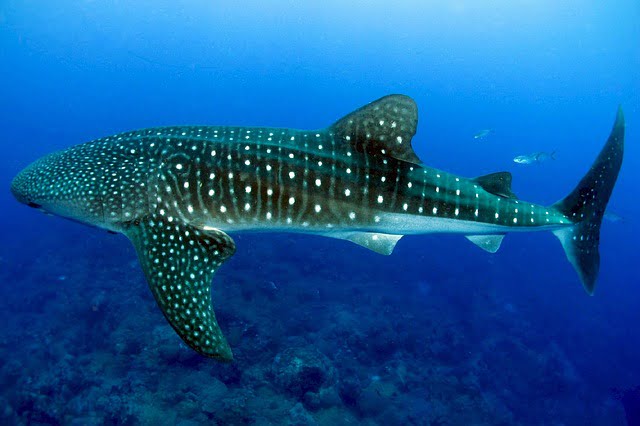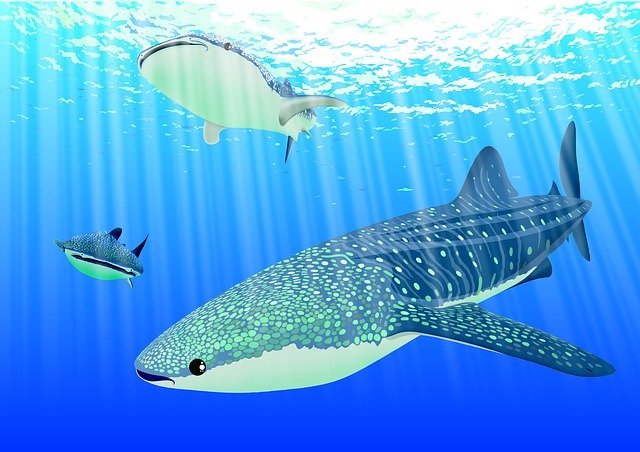This article discusses extensively on the puzzling topic whether whale sharks are whales or sharks.
Are whale sharks whales or sharks?
Whale sharks are sharks not whales. They are the largest extant fish species currently inhabiting the open waters of the tropical oceans and they belong to the family of fish known as sharks, identified by have cartilaginous skeletons.
Why are whale sharks called ‘whale’ sharks?
Adult whale sharks are extremely enormous in size. They are the largest known extant fishes in the world and the biggest living non-mammalian vertebrate that currently roam the surface of earth.
Because of this sheer enormity in size which greatly contrast the size of most fishes; including the majority of shark species, and rivals the expansiveness of most cetaceans which includes dolphins, porpoise and some blue whale subspecies, whale sharks have been fittingly awarded the prefix “whale” before their regular family name, shark. So they are more commonly referred to a whale sharks (Rhincodon typus).

Another thing that justifies the addition of the prefix ‘whale’ to their family name is the common feeding similarities they share with all baleen whales.
Both class of marine animals employ a method of feeding known as filter-feeding and they both prey on similar sea organisms which includes planktons and algal phytoplankton.
Did you know? The largest recorded specie of whale shark stretched an whopping 18 meters from head to tail and weighed a staggering 31 tonnes (34.2 tons) [1].
Whale sharks taxonomical classification
Before we begin, and if you are not already familiar with taxonomical grouping of living organisms, here is a very useful summary to begin with.
Taxonomy is basically the classification of all living organism based on some commonly shared characteristics. For instance, the sorting of animals based on their cell structure; whether one celled or multiple celled, cell type; whether eukaryotic or prokaryotic, morphology and physiology; whether possessing body hair, mammary glands and endothermic systems or not, behavioral; wether active at night or in the daytime or twilight. and many more, including biochemical and generic terms.
A well balanced (not perfect) combination of all these criteria and factors enable scientist to be able to identify organisms that are more closely related to another than with other species and allow for reasonable grouping or classification. This also aids scientific study by multitude of levels.
The five main ranking system currently employed in taxonomy includes the: Domain, Kingdom, Phylum, Class, Order, Family, Genus and Species. This ranking structure is sort of ‘reverse hierarchical’, which means that it start off with a very loose criteria at the beginning; the domain: containing all living organism that share a very common and non-specific characteristics, for a relative example, a group of living organism that consist of all humans that are males regardless of the age, talent, social class, occupation, religion etc., and then continues to taper down significantly with each progressive level governed by stricter and stricter criteria, for example, all males that are bankers, have bald heads, can play football and can whistle with their index and thumb fingers in their mouth.
This narrowing continues until the very end of the rank (the species) which contains all organism that are so closely related to one another that they can actually interbreed.
Back to the whale classification
Now that you at least have a birds eye view on how living organism are classified, let use revert back to the taxonomical classification of whale sharks.
Whale sharks first and foremost are multicellular organisms with eukaryotic cells which (together with a few more traits), cause for their classification within the domain Eukarya, the other two domains of life include the Archaea and Bacteria.
Next, whale sharks share all the characteristics and traits that govern the placement of Eukarya organisms under the kingdom animalia, and as such, they are placed there. One of the most notable trait of members of the kingdom animalia is their inability to produce their own food and must consume other organism in order to derive sustenance.
Going froward with the reverse hierarchal ranking system, and in the same manner of classification: using factors and criteria, whale sharks are grouped under the
- Phylum Chordata
- Class: Chondrichthyes
- Order: Orectolobiformes
- Family: Rhincodontidae
- Genus: Rhincodon
- and Species: R.Typus
Taxonomical classification of whale sharks
- Domain (Eukarya)
- Kingdom (Animalia)
- Phylum (Chordata)
- Sub-phylum (Vertebrates, fishes)
- Class (Chondrichthyes a.k.a Cartilaginous fishes)
- Sub class (Elasmobranchil)
- Order (Orectolobiformes)
- Family (Rhincodontidae)
- Genus (Rhincodon)
- Species (R. typus)
To expand the readers knowledge even further, let us expound briefly on the sub-phylum: Fishes.
All fishes currently extant in the world belong to either of three classes mentioned below.
- Bony fish
- Cartilaginous fish
- Jawless fish
All sharks belong to the Cartilaginous fish class including whales sharks. Whale sharks together with all other family of sharks, rays, skates and saw fish share the Elasmobranchii sub-class of cartilaginous fishes. The other second sub class of cartilagenous fishes: Holocephali, is occupied by rat fishes and elephant fishes.
Whale shark forms the only extant member of the Rhincodontidae Family and the only sole member of the Rhincodon Genus.
(Refer to the taxonomical classification above to make sense of the context)
How do whale sharks differ from whales?
The parting of whale sharks form cetacean whales starts right from the subphylum classification: Whale sharks are classified as vertebrate cartilaginous fishes whereas cetacean from dolphins, porpoise to all whales species are classified as vertebrate mammals.
There are many characteristics that set the fine line between fishes and mammals, marine mammals to be more specific. The most notable ones from both the fish and mammalian perspective include.
a) Fishes have gills for breathing underwater, mammals use lungs and require air. All cetaceans including whales surface from underneath water to catch a breath. Whale sharks on the other hand posses gills which they use to filter out dissolved oxygen from ocean water.
b) Fishes are exothermic, most mammals are endothermic. Whales generate their own body heat and keep their body temperatures at a near constant range. Whale sharks on the other hand rely solely on external temperature of the surrounding water to regulate their body temperatures. During cold conditions, whales sharks and all other fishes inhabiting the oceans get internally cold and consequently inactive, and during hot climate, they get pretty hot and become vividly active. They may choose to migrate to warmer regions to prevent being active.
c) Fishes are oviparous and are un-solicitous towards their young, most mammals are viviparous and are solicitous toward their newly born. Whale sharks give birth to their young ones and abandon them to fend for themselves. Whales on the other hand nurture and suckle their young with breast milk until they are capable of fending for themselves and surviving on their own. Mammary glands (or breasts) by the way is one of the four main peculiarities that all mammals share.
d) Fishes lack body hair, mammals have body hairs. Whale sharks do not have body hairs, all whales grow hair during their fetal stages and some still retain a good amount of this hair (mostly around their facial region) during adulthood.
e) All fishes move their bodies by action of horizontal stroking of their tails. Whales do the opposite, they move their bodies by action of vertical stroking of their tails. Whale sharks, being fishes, move by means of horizontal stroking whereas Whales move by vertically stroking their tails.
To learn extensively what makes cetaceans like whales, dolphins and porpoise mammal, read the article below.
More interesting whale shark articles
Cite this Article ” (APA Format)
Bunu. (2020, June 2). Whale shark: whale or shark? Retrieved from http://emborawild.com/whale-shark-whale-or-shark/

